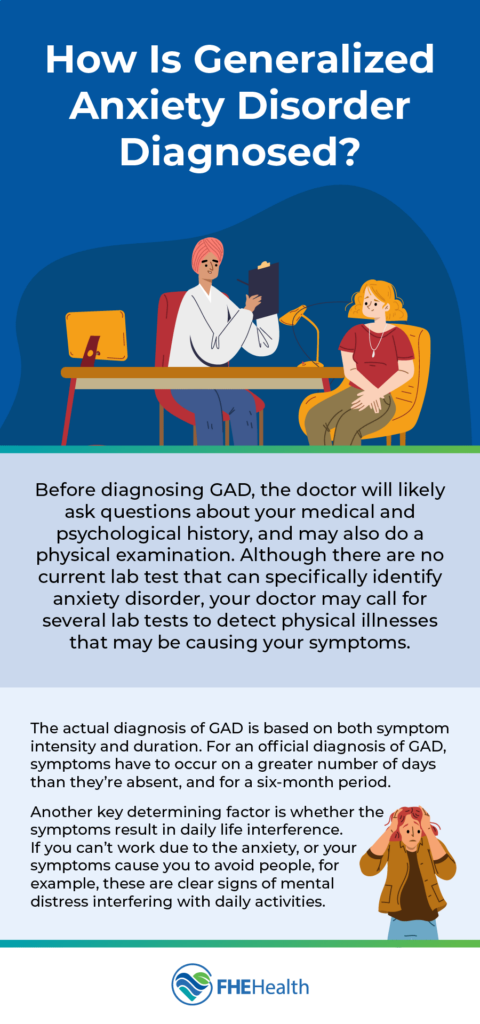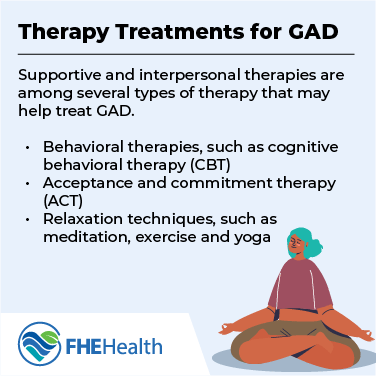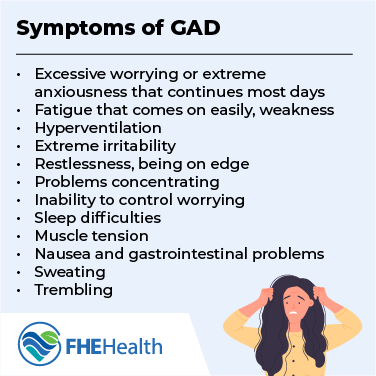Anxiety disorders are not uncommon in America, with 40 million adults experiencing anxiety during the course of a year. However, non-stop worry and anxious thoughts may signal the onset of generalized anxiety disorder (GAD).
Excessive anxiety and worry that’s ongoing and completely out of proportion to what’s normal, plus an inability to control thoughts of impending doom to the point where you can’t function in everyday activity may be an indication of GAD.
How Common is GAD?
An estimated 40 million U.S. adults experience anxiety disorder in any given year, making anxiety the most common mental illness in America. According to the Anxiety and Depression Association of America, generalized anxiety disorder is common and affects nearly 7 million adults in the U.S. each year. Women are twice as likely as men to be affected.

While GAD has symptoms that may be in common with other anxiety disorders, it is its own mental health condition. GAD facts show that it can, and often does, co-occur with other anxiety and mood disorders.
How Is Generalized Anxiety Disorder Diagnosed?
Before diagnosing GAD, the doctor will likely ask questions about your medical and psychological history, and may also do a physical examination. While lab tests are commonly ordered for many medical conditions, no current lab test can specifically identify anxiety disorder. Still, your doctor may call for several lab tests to detect physical illnesses that may be causing your symptoms.
The actual diagnosis of GAD is based on both symptom intensity and duration. The doctor also takes into consideration the functional problems that the symptoms cause. Do these symptoms and dysfunction match a specific anxiety disorder? For an official diagnosis of GAD, symptoms have to occur on a greater number of days than they’re absent, and for a six-month period.
Another key determining factor is whether the symptoms result in daily life interference. If you can’t work due to the anxiety, or your symptoms cause you to avoid people, for example, these are clear signs of mental distress interfering with daily activities.
Is There Treatment for GAD?
 If you have a medical condition causing your symptoms, the doctor will address treatment for that specific condition. However, in the absence of a medical condition responsible for your symptoms, the doctor may refer you to mental health professionals, typically psychiatrists and psychologists, who are trained to diagnose and treat in GAD and other types of mental illness.
If you have a medical condition causing your symptoms, the doctor will address treatment for that specific condition. However, in the absence of a medical condition responsible for your symptoms, the doctor may refer you to mental health professionals, typically psychiatrists and psychologists, who are trained to diagnose and treat in GAD and other types of mental illness.
Therapy
Supportive and interpersonal therapies are among several types of therapy that may help treat GAD.
- Behavioral therapies, such as cognitive behavioral therapy (CBT), are both well-researched and proven to help treat GAD. CBT helps by targeting the kinds of thoughts, behaviors and physical symptoms so common with GAD, including the obsessive need to over-prepare and plan, as well as avoidance behavior.
- Acceptance and commitment therapy (ACT) is another mindfulness-based behavioral therapy that may help in the treatment of GAD.
- Relaxation techniques, such as meditation, exercise and yoga, and alternative therapies may also be included in a GAD treatment plan.
Since many individuals diagnosed with GAD also have depression, other anxiety disorders, or a substance use disorder, appropriate treatments must simultaneously address these co-occurring conditions.
Medication Options
The National Institute on Mental Health (NIMH) lists several classes of medications that doctors may prescribe in anxiety treatment: antidepressants, anti-anxiety medications and beta-blockers.
- Two commonly used antidepressants, selective serotonin reuptake inhibitors (SSRIs) and serotonin-norepinephrine reuptake inhibitors (SNRIs), may be used. Other antidepressants that have also shown effectiveness in treating GAD that could be prescribed are monoamine oxidase inhibitors (MAOIs) and tricyclic antidepressants.
- Anti-anxiety medications, which are only prescribed for short-term use, may help with the extreme worry and fear and other GAD symptoms. However, they can be addictive, especially if you take them for extended periods of time, or have problems with substance abuse.
- Another class of drugs that can be prescribed to reduce some of GAD’s physical symptoms, such as trembling, increased heart rate and shaking, and acute anxiety attacks, is beta-blocker medication.
Symptoms of GAD
Some of the common symptoms of GAD include:
- Excessive worrying or extreme anxiousness that continues most days
- Fatigue that comes on easily, weakness
- Hyperventilation
- Extreme irritability
- Restlessness, being on edge
- Problems concentrating
/su_column]
- Inability to control worrying
- Sleep difficulties
- Muscle tension
- Nausea and gastrointestinal problems
- Sweating
- Trembling
Can GAD be Caused by Something?
 Science hasn't found a specific single cause for GAD, or other types of anxiety disorders. Research does, however, point to the fact that GAD and anxiety disorders tend to run in families, so there may be a genetic component to GAD onset.
Science hasn't found a specific single cause for GAD, or other types of anxiety disorders. Research does, however, point to the fact that GAD and anxiety disorders tend to run in families, so there may be a genetic component to GAD onset.
Studies have also shown that certain environmental factors may play a role in the development of GAD. Childhood abuse, neglect and a dysfunctional family can contribute to the onset of GAD, which is particularly important since many anxiety disorders, including GAD, develop in childhood and during young adult years. Yet any lifetime experience of trauma, as well as post-traumatic stress disorder (PTSD), can serve as contributing factors to GAD.
Are There Triggers/Phases for GAD?
An upcoming event or worry about a pending work, home or school project can trigger the heightened anxiety characteristic of GAD. In addition, drinking too much of the stimulant caffeine may be a GAD trigger.
Major life stressors, worrying about the future, fears about death, loneliness, claustrophobia, being in unfamiliar situations, fearful of trying anything new, being among strangers, feeling put on the spot, money issues, unrealistic self-expectations and other situational and emotional issues may also trigger GAD.
While there aren't necessarily phases for GAD, it can begin early and progressively get worse. A GAD diagnosis can be disheartening, but it's when the disorder prevents you from normal functioning and impairs concentration, interferes with relationships, increases fatigue and depression that it becomes debilitating.
When Does GAD Typically Appear?
According to the National Alliance on Mental Illness (NAMI), most of the 40 million U.S. adults with anxiety develop symptoms before they're 21 years old. In addition, each year about 7.1 million children between the ages of 3 and 17 experience problems with anxiety.
Can GAD be Cured?
Since there's no specific cause for GAD, there is no cure. You can, however, get better with treatment. Indeed, GAD and other mental health conditions are highly treatable, so getting help early and being actively involved in your treatment plan will produce the best outcomes. If you are prescribed certain medications to help you cope with GAD, there may be a point where your doctor will recommend discontinuing them. If you've been in psychotherapy, undergoing CBT or other behavioral therapies, you will gain valuable insight into behavior and lifestyle changes that help you better cope with the symptoms of GAD. While there's no cure for GAD, you can learn to live with and manage GAD.
Here are some ways to proactively deal with anxiety:
- Engage in relaxation techniques. Meditation and yoga can help reduce stress, combat worry, and increase a sense of grounding and calmness. Yoga, which focuses on meditation and breath work, teaches you how to look inward.
- Take some deep breaths. Try a simple, quick exercise called box breathing, which helps reduce stress and improves concentration. Inhale to a count of four, exhale to a four-count, hold for another count of four at the bottom of the exhale, and repeat.
- Sleep well, eat healthy and reduce caffeine. If you're worn out from lack of sleep, or you've been sleeping fitfully, your anxiety levels are likely to rise. Cultivate good sleep habits so you get the rest you need. Similarly, poor eating habits won't provide the nutrients you need to feel your best, so focus on healthier eating. Also, cut back on caffeine, a powerful stimulant, which can also amp up anxiety.
- Skip alcohol and drugs. Alcohol is a depressant, which may also heighten anxiety and make you depressed. Drugs blur rational thought and may trigger risky behavior. Neither alcohol nor drugs are effective ways to cope with GAD.
- Be sure to exercise. Much of the daily tension and stress can be dissipated through vigorous exercise. It's the endorphin rush you naturally get from exercise that also helps lift mood and make problems seem less difficult or unsolvable.
- Make sure to take prescribed medication. You may want to get off prescription medicine, yet only do so when and if your doctor says it's the right time.
- Learn how to face your fears. Professional counseling can help you get past crippling anxiety by helping you confront situations, past and present, where you feel powerless and afraid. With such compassionate and encouraging counseling, you'll be better equipped to deal with GAD's anxiety and doubt and move past it.
Instead of agonizing with GAD, ask for help. Contact FHE Health today so you can get the right diagnosis and effective combination of treatments to help you resume your life without GAD's debilitating constraints.








